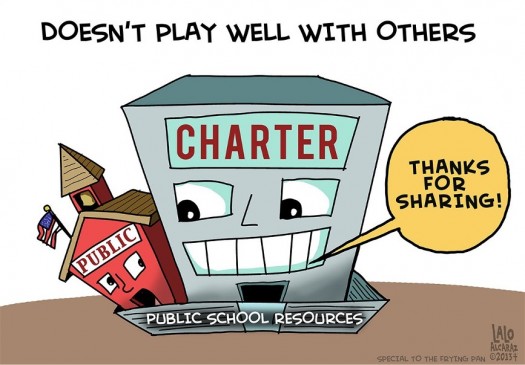Do charters and vouchers hurt public schools? The answer is “yes”

Do charter schools, school vouchers and online schools really hurt our neighborhood public schools? You bet they do.
Charter schools, vouchers, and other “choice” options redirect public money to privately operated education enterprises, which often operate for profit. That harms public schools by siphoning off students, resources, and funding while reducing the ability of your public schools to serve the full range of student needs and interests.
This is why
The idea that “the money should follow the child” when students leave a public school for other options is a bad financial decision.
Schools have “stranded costs”. When a public school loses a percentage of students to charter schools or a voucher program, the school can’t reduce costs by an equivalent percent. The school still must pay the same utility, maintenance, transportation, and food services costs. The school must still carry the salary and benefit costs of administrative staff, custodial services, and cafeteria workers. The school may not be able to reduce teaching staff because the attrition will occur randomly across various grade levels, leaving class sizes only marginally reduced.
Students aren’t a “one-off” expense. The cost to educate each individual student varies a lot. Students with disabilities or who don’t speak English as their first language often cost significantly more to educate. So as a school loses students, it may often find itself left with a larger percentage of its highest-cost students.
When schools lose students, they have to cut services. Because schools can’t reduce expenses incrementally, they cut support staff – such as a reading specialist or librarian – and courses – such as art and music – that engage the diverse needs and interests of students.
Look at the facts
In Nashville, TN, an independent research firm MGT of America estimated the net negative fiscal impact of charter school growth on the district’s public schools result in more than $300 million in direct costs to public schools over a five-year period. [1]
Another study by MGT in Los Angeles, CA found district public schools lost $591 million due to dropping enrollment rates among students who leave and go to charters. [2]
A research study of school districts in Michigan found that choice policies significantly contribute to the financial problems of Michigan’s most hard-pressed districts. When the percent of students attending charter schools approaches 20 percent, there are sizeable adverse impacts on district finances. [3]
In New York, a study found that in just one academic year the Albany school district lost $23.6 – $26.1 million and the Buffalo district lost $57.3 – $76.8 million to charter schools. Because charters in both districts had smaller percentages of limited English proficient students, and charters in Albany enrolled fewer students with disabilities, the affected public schools were unable to reduce spending on English as Second Language and special education services. [4]
Privatizers Believe: Money should follow the child; We Believe: Children should not have a price tag.
Privatizers Believe: Parents need choice; We Believe: Parents need a guarantee of high-quality schools, close to home, for every child.
Privatizers Believe: Parents should vote with their feet; We Believe: Parents should have a voice in schools that serve the whole community.
Privatizers Believe: School governance should be corporate; We Believe: Communities should govern schools by electing school boards.
The Bottom Line
In any policy discussion of education, the goal should be to provide the best possible system for all children, given the resources available. While alternatives to public schools may provide better options for some children, on the whole, charter and voucher schools perform no better than the public school system, and often worse. At they same time they have a negative fiscal impact on existing public schools, and are creating a parallel school system that duplicates services and costs. Let’s stop draining our public schools and work together to strengthen them instead.
[1] “Charter School Financial Impact Model Final Report,” MGT of America, September 11, 2014, http://nashvillepublicmedia.org/wp-content/uploads/2014/09/MNPS-Charter-Schools-Financial-Impact-Review.pdf[2] “Review: Fiscal Impact of Charter Schools on LAUSD,” MGT of America, May2016, stofcharterschools.org/ccs/eir/
[3] “Which Districts Get Into Financial Trouble and Why: Michigan’s Story,” David Arsen, Thomas A. DeLuca, Yongmei Ni, and Michael Bates, Michigan State University, November 2015, http://www.education.msu.edu/epc/library/papers/documents/WP51-Which-Districts-Get-Into-Financial-Trouble-Arsen.pdf
[4] Fiscal Impacts of Charter Schools: Lessons from New York, Robert Bifulco and Randall Reback, Columbia University, New York, NY, http://www.columbia.edu/~rr2165/pdfs/nycharterfiscal.pdf
Do charters and vouchers hurt public schools? The answer is "yes" - Network For Public Education:
